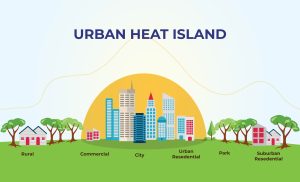Ellie Gabel details how microclimate engineering can use sustainable design, green spaces and smart technologies to combat urban thermal islands, improve air quality and create cooler and healthier cities.
The urban surface can trap heat and raise local temperatures, leading to increased energy consumption due to cooling and air quality issues.
MicroClime Engineering adopts sustainable practices to address urban challenges and improve the quality of urban life.
Understanding urban microclimates
A urban microclimate is atmospheric conditions in areas that are different from those surrounding areas. A major example is the urban heat island effect, where cities are warmer than nearby rural towns.
The most important factors for the urban heat island effect are:
Solar radiation contained in the surface, green space percentage, and population density percentage.
Data from 65 US cities show that the urban heat island effect raises temperatures of about 8 degrees Fahrenheit, with different heat intensity in urban areas.
Cincinnati is concentrated in the core, Chicago is spreading into intense heat zones, and Houston is spreading across vast, developed lands.
Microclimate engineering principles
Microrimes engineering is a practice that manages and modifys the local climate to increase comfort, functionality or sustainability.
City design, material selection, and vegetation all play a role in effectively controlling the thermal environment. There are two main strategies.
Passive cooling utilizes natural elements such as ventilation, shade and thermal mass to minimize the need for mechanical cooling. Active cooling methods include mechanical systems such as fans, pumps, and refrigeration to remove heat when passive strategies are insufficient.
Innovative technology and nature-based solutions
The types of materials used in urban architecture may be in favor or against the urban heat island effect. Because metal is a thermal conductor, it quickly absorbs and transmits heat, and the thermal mass of concrete and bricks is high.
In general, darker colors absorb more heat. Conversely, light colour or reflective surfaces can bounce off sunlight rather than absorbing them. The windows can be used with reflective film and awnings, while the roof can be painted with a very reflective coating.
Green spaces and vegetation also help reduce the urban heat island effect by providing shade that lowers surface temperatures. The trees in urban parks can remove up to 711,000 tons of aerial toxins each year, improving the environment and public health.
In addition to urban forests, cities can implement green roofs and walls, or water-based cooling systems such as fountains and Mr.
Another important innovation is the integration of smart technology. Real-time sensors monitor environmental factors such as temperature, humidity and sunlight. Adaptive systems can use this live and historical data to improve efficiency and cooling.

Global leader in urban cooling
Several cities around the world are fighting cooling technology with microclimate and urban heat island effects.
Singapore’s Green Plan 2030 is intended to significantly expand the park network and restore the natural urban environment. These ambitious goals include planting an additional million trees and ensuring that every home is within a 10-minute walk from the park. Streetsla is a cool Los Angeles paving program that uses coatings that reflect infrared rays and reduce heat absorption. On typical sunny days, the ambient temperature drops by 1.5°F, and on extremely hot days, it has a much larger reduction of up to 3.5°C. Fraîcheur de Paris is currently the widest urban cooling system in Europe. To meet the growing demand for air conditioners, Paris draws water from the Seine into the cooling station and underground pipes.
Planning and Community Engagement
The policy framework supports microclimate engineering at various government levels. EPA’s Heat Island Community Action Database includes essential and voluntary actions on city heat mitigation, including green construction codes, urban forestry grants and cool pavement pilot programs.
On a more local level, Miami’s eternal climate is ready: The Extreme Heat Plan offers action to deal with the heat around it by focusing on shade, water and design.
In Europe, policy equipment promotes urban nature-based solutions (NBS) addressing environmental and social challenges, while the French MAPUCE project uses microclimate and energy data to establish a framework for considerations in public policy.
Microcryer Merit Engineering is at its best when urban planners, scientists and communities work together to develop comprehensive solutions.
City heat islands disproportionately affect low-income and communities of color compared to predominantly white residents, which emphasize the importance of equity and access in addressing this issue. Urban planning should take accessibility and inclusiveness into consideration.
Trends and research needs in urban design
While global climate change continues to increase urban heating and weather phenomena, a microclimate engineering approach can help manage effectiveness.
As many cities increasingly prioritize green infrastructure and other NBS, further research should focus on continuously assessing its effectiveness and developing innovative ways to integrate solutions into existing urban environments.
Resilience and sustainable infrastructure are another focus of urban design. The construction process generated an estimated 37% of global emissions in 2022.
New infrastructure can be designed to incorporate renewable energy sources during the construction and operational stages. This will help reduce carbon emissions, which will greatly contribute to atmospheric warming.
Emerging trends in microclimate engineering include artificial intelligence, the Internet of Things, digital twins, and climate modeling.
These allow for improved decision-making based on real-time data. Microcrat engineers need to explore how innovative technology can help optimize urban operations.
I’ll start creating a cooler tomorrow
Controlling the thermal environment can improve quality of life in urban areas.
City planners can take a passive or aggressive approach to mitigate city heat islands, from planting plants and using bright colors to installing humidity sensors and solar power fans.
Continuous innovation and collaboration can lead to the development of cooler urban spaces.
Source link

